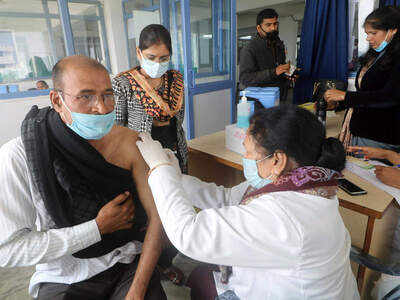Top Searches
- News
- India News
- Centre's campaign to step up vaccinations among tribals to focus on quelling myths, facilitating jabs
Centre's campaign to step up vaccinations among tribals to focus on quelling myths, facilitating jabs

Representative image
NEW DELHI: The Centre will set off a campaign to step-up vaccination among tribals living in forest areas through an outreach that will focus on busting myths, quelling commonly expressed fears and also facilitate vaccinations.
The nerve centre of all village activity in the tribal belt—the weekly “Haat Bazaars”—are set to be one of the key focal points of the campaign that will be launched on Thursday starting from Bastar in Chhattisgarh and Mandla in Madhya Pradesh.
Tribal Cooperative Marketing Development Federation (TRIFED) managing director Pravir Krishna said that they have also written to the Union health ministry and the state authorities to facilitate vaccination of tribals as part of this campaign.
Some of the barriers that lead to vaccine hesitancy have been identified based on available evidence. The campaign will therefore work on busting myths and misinformation and presenting facts to counter concerns about safety, fear of side effects, infertility and misconceptions that vaccines can cause death.
TRIFED estimates through various local platforms the campaign will be able to build awareness on vaccination among nearly 50 lakh tribals and forest dwellers as the campaign expands across states. Steered by TRIFED that falls under the purview of the ministry of tribal affairs, the campaign to accelerate demand for vaccination will be carried out in collaboration with UNICEF.
It will take off with tribals who are part of the Self Help Groups and ground workers running the 37800 plus Van Dhan Vikas Kendras that value add to non- timber minor forest produce to enhance its market value to boost livelihood opportunities.
Officials explain that the campaign will also address concerns about accessibility for registration and transportation to vaccination centres. “Besides community outreach through conversations, messages using tribal motifs and dialect will be put up to enhance visibility at common touch points like fertilizers outlet centres, haats and markets, VDVK kendras, milk collection points. From wall paintings, to pre-recorded messages in local language, miking in haat bazaars to tribal folk music - all this will also be used to share information,” an official explained.
The nerve centre of all village activity in the tribal belt—the weekly “Haat Bazaars”—are set to be one of the key focal points of the campaign that will be launched on Thursday starting from Bastar in Chhattisgarh and Mandla in Madhya Pradesh.
Tribal Cooperative Marketing Development Federation (TRIFED) managing director Pravir Krishna said that they have also written to the Union health ministry and the state authorities to facilitate vaccination of tribals as part of this campaign.
Some of the barriers that lead to vaccine hesitancy have been identified based on available evidence. The campaign will therefore work on busting myths and misinformation and presenting facts to counter concerns about safety, fear of side effects, infertility and misconceptions that vaccines can cause death.
TRIFED estimates through various local platforms the campaign will be able to build awareness on vaccination among nearly 50 lakh tribals and forest dwellers as the campaign expands across states. Steered by TRIFED that falls under the purview of the ministry of tribal affairs, the campaign to accelerate demand for vaccination will be carried out in collaboration with UNICEF.
It will take off with tribals who are part of the Self Help Groups and ground workers running the 37800 plus Van Dhan Vikas Kendras that value add to non- timber minor forest produce to enhance its market value to boost livelihood opportunities.
Officials explain that the campaign will also address concerns about accessibility for registration and transportation to vaccination centres. “Besides community outreach through conversations, messages using tribal motifs and dialect will be put up to enhance visibility at common touch points like fertilizers outlet centres, haats and markets, VDVK kendras, milk collection points. From wall paintings, to pre-recorded messages in local language, miking in haat bazaars to tribal folk music - all this will also be used to share information,” an official explained.
FacebookTwitterLinkedinEMail
Start a Conversation
end of article
Quick Links
Coronavirus in MumbaiFarm bill 2020Farmers protestCoronavirus in DelhiCoronavirus in BangaloreCoronavirus symptomsCoronavirus in IndiaWest Bengal elections 2021Coronavirus NewsSolar EclipseNPRWhat is NRCCAB BillCAB and NRCAssam election 2021Podcast newsLok SabhaTamil Nadu Election 2021CongressBJP newsKerala Elections 2021Indian ArmyISRO newsSupreme Court

